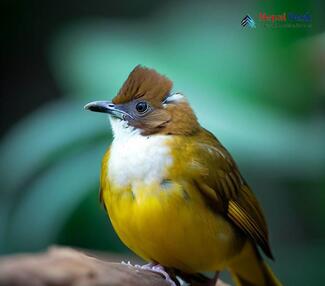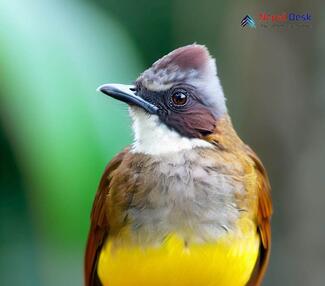The White-throated Bulbul (Alophoixus flaveolus) is an extraordinary bird species inhabiting various regions of Asia, including Nepal. With its unique physical attributes and captivating lifestyle, this bird has caught the attention of birdwatchers and nature lovers alike. In this article, we will dive into the classification, physical traits, habitat, diet, reproductive and nesting behaviors, interesting tidbits, and the White-throated Bulbul's presence in Nepal.
Classification and Physical Traits
As a member of the Pycnonotidae family, the White-throated Bulbul is related to various bulbuls and greenbuls. They share a close relationship with other species within the Alophoixus genus. British zoologist Edward Blyth bestowed the scientific name 'Alophoixus flaveolus' upon them in 1855.
The White-throated Bulbul is a medium-sized bird, with a body length of about 20-22 cm and weighing between 30-50 grams. Its upper parts feature an olive-green hue while its underparts showcase a warm yellow color. The most distinctive characteristic is the white throat patch which contrasts strikingly with the dark cheek patch. This bird also possesses a noticeable crest atop its head and a somewhat hooked bill suited for its natural diet.
Habitat and Diet
Primarily found in subtropical or tropical moist lowland forests, particularly where dense undergrowth exists, these bulbuls inhabit countries such as Bangladesh, Bhutan, India, Myanmar, Thailand, and Nepal. Within Nepal, they can usually be spotted at elevations ranging from 150 to 2,500 meters above sea level.
White-throated bulbuls predominantly follow an omnivorous diet, feeding on a variety of fruits, berries, and insects found within their forest homes. Their specialized bill enables them to effortlessly grasp soft fruits and adeptly catch small insects. Occasionally, they also consume flower nectar as an additional food source.
Reproduction and Nesting
Their breeding season typically extends from April to June. White-throated bulbuls create cup-shaped nests fashioned from twigs, roots, and leaves that are carefully woven together to form a robust structure. These nests are usually placed near banks or ravines, hidden within thick undergrowth or vegetation. Females tend to lay two to three eggs per clutch, which incubate for approximately 12-14 days before hatching.
Interesting Facts
- Their distinct call resembles a melodic whistle often heard during early mornings or evenings.
- This bird is known to perform aerial acrobatics when catching insects.
- White-throated bulbuls can frequently be observed hanging upside-down as they search for food on branches.
- These social birds often converse with other bulbul species and form mixed-species flocks.
Existence in Nepal
The elusive White-throated Bulbul can be found scattered throughout various regions in Nepal, particularly in protected zones such as Shivapuri Nagarjun National Park and Annapurna Conservation Area. Catching a glimpse of these hard-to-find birds provides birdwatchers with a tremendously satisfying experience while delving into the incredible biodiversity of Nepal.
In summary, the White-throated Bulbul is an eye-catching bird species worthy of attention due to its intriguing features and remarkable presence throughout Nepal. This melodious avian wonder not only captivates birdwatching enthusiasts but also adds to the abundant biodiversity found in Nepal's forests. By spreading awareness about this mesmerizing creature, we foster a deeper understanding of its ecological importance and inspire efforts to safeguard its valuable habitat so that future generations can appreciate it too.




